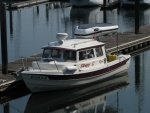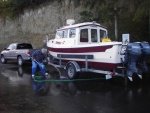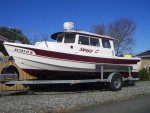You are using an out of date browser. It may not display this or other websites correctly.
You should upgrade or use an alternative browser.
You should upgrade or use an alternative browser.
Remove very old vinyl boat numbers
- Thread starter C-Val
- Start date
South of Heaven
New member
They will always come off with heat (no matter how old they are), thats not the issue. The issue is the sun fade on the gelcoat.
On my new boat I can clearly still see the old graphics at different angles! I hate that.....
On my new boat I can clearly still see the old graphics at different angles! I hate that.....
SENSEI":1vww5vhp said:on the new Sensei, I used a razor blade to get the 1995 graphics off then wiped it off to get the glue residue off with good ol 87 octane gasoline. it removed the film with ease
Is that ethanol free gasoline? ....................only joking.
If you don't have a drop of gasoline or "Goo Gone" handy, good 'ol WD 40 does the same job.
Martin.
South of Heaven":nul4ks74 said:The issue is the sun fade on the gelcoat.
I just removed the pin stripe on the hull line. You could see the gelcoat had yellowed compared to the white under the stripe. I used some 3M Finesse compound and a polisher to remove the yellowing. Our boat is an '07 and is parked on the trailer outside. Will it work all the time? I doubt it. But worth a try.
starcrafttom
Active member
so at the Fh gathering I picked up a set of original cdory decal complete with the original factory address. This is wonderful because my old ones are in really bad shape. These are not vinyl ( i think ). would heat be the best way to get them off?
I had to remove a 3M "Diamond Shield" on the front of my RV--and not damage the paint. These are far more tenacious than the vinyl we use on names and numbers etc. I found a combination of "ZEP" or any other good citrus spray, (Home Depot), and a plastic razor blade made the job as easy as possible. I just did the name and numbers on "Thataway"--and it was a 20 minute job. Someone had used steel razor blades in the past--and it showed. I never use them on a fiberglas or painted vehicle!. Heat might have made it a little faster (and I did use heat on the RV). Don't get it too hot, or you can damage the gel coat! Clean up with Goof Off, or WD 40 (one of the few things it is good for). As Local Boy, I compounded the area where both the numbers and name was. First I wanted fully clean and wax for the new graphics, plus I didn't want to compound over new vinyl--that is a great way to ruin the graphics!
Wear Nitrile gloves; Best I have found are Harbor Freight, 9 mil--really last and fit!
Wear Nitrile gloves; Best I have found are Harbor Freight, 9 mil--really last and fit!
The problem I found is that even with the old lettering removed, you can still see what was there because the gelcoat fades/weathers differently when covered by the vinyl. Unless you are replacing identical lettering you are going to see what was there before.
I had a FG RIB once. Before I bought it they took the old lettering off the hull. However, for as long as I owned the boat, you could still pretty clearly make out the old name on the transom.
I had a FG RIB once. Before I bought it they took the old lettering off the hull. However, for as long as I owned the boat, you could still pretty clearly make out the old name on the transom.
ssobol":bh0k970w said:The problem I found is that even with the old lettering removed, you can still see what was there because the gelcoat fades/weathers differently when covered by the vinyl. Unless you are replacing identical lettering you are going to see what was there before.
This is basically a problem for the boat owner--and the rest of the world are not so hyper critical, we don't go looking for old shadows...or ghosts. Generally I find that I see the old name, but no one else pays any attention to it.
Robert H. Wilkinson
New member
You can buy a rubber wheel at auto body supply stores that you use on a drill. Works well on cars - never tried them on fiberglass. Keep it flat, keep it moving - don't hold in one place too long or with too much pressure.
PaulNBriannaLynn
New member
When using chemicals to get rid of the adhesive, start with a small test area. I tried to use an industrial strength Goo gone to get rid of the crystalized adhesive on our Parker, and it discolored the hull. Luckily it was a small spot not noticeable but I switched to something a little less heavy duty, like orange gone or something like that.
Salmon Fisher
Member
The problem I am having is that the ghosted lettering from the old registration is "raised up." It is like the gelcoat underneath the old lettering hasn't "weathered." The gelcoat around where the old lettering was is slightly lower and the old lettering area is proud of the surrounding gelcoat.
I have read to use 600 grit sanding the old lettering down to the existing gelcoat level. Is this advisable?
Thanks everyone.
I have read to use 600 grit sanding the old lettering down to the existing gelcoat level. Is this advisable?
Thanks everyone.
Pacificcoast101
Member
I use a hair dryer to peel away old stickers, then spray toilet bowl cleaner over the area. In a few minutes, it looks much better. By the next day, it looks brand new.
https://www.youtube.com/watch?v=AEGolbLmAYo
https://www.youtube.com/watch?v=AEGolbLmAYo
I would be interested in hearing from some of the chemists and technical folks on board about using that on the boat and especially about getting it on the trailer (Galvanized in my case). I like the spray bottle mix if that isn't damaging to gel coat, glass or trailer. That would be great especially for the up north ramps where there isn't much in the way of wash down access. Looks like that and a bucket and big sponge could do the trick.
Harvey
SleepyC :moon

Harvey
SleepyC :moon

Pacificcoast101
Member
I've been using it for years without issue. I use the non-bleach version.
Warning;
: Do not mix with chlorine-type bleaches or other household
chemicals.
Reacts with household chemicals such as bleach based toilet bowl
cleaners, rust removers, vinegar, acids or ammonia containing products to
produce chlorine containing hazardous gases.
Chlorine containing gases can be produced.
http://content.rpgov.net/dpw/right_to_know/Libary/The Works Toilet Bowl Cleaner.pdf
Warning;
: Do not mix with chlorine-type bleaches or other household
chemicals.
Reacts with household chemicals such as bleach based toilet bowl
cleaners, rust removers, vinegar, acids or ammonia containing products to
produce chlorine containing hazardous gases.
Chlorine containing gases can be produced.
http://content.rpgov.net/dpw/right_to_know/Libary/The Works Toilet Bowl Cleaner.pdf
OK,I get to not mix with chlorine of any kind. I went through an MSDS.
There is some wording about warning about contact with certain metals. Of course it does not say which or what finishes.
So, More specifically my questions is two fold. 1. is about mixing with hydrogen peroxide -- if there is an advantage or a warning. and 2. What are the expected consequences of getting it on my Galvanized trailer, ( if there will be damage and/or if it is rinsed off right away, would it not be a problem.
Harvey
SleepyC :moon

There is some wording about warning about contact with certain metals. Of course it does not say which or what finishes.
So, More specifically my questions is two fold. 1. is about mixing with hydrogen peroxide -- if there is an advantage or a warning. and 2. What are the expected consequences of getting it on my Galvanized trailer, ( if there will be damage and/or if it is rinsed off right away, would it not be a problem.
Harvey
SleepyC :moon

Pacificcoast101
Member
I haven't mixed it with anything. The non-bleach toilet bowl cleaner makes the hull shiny and white as new straight out of the bottle. It's 9.5% HCL so rinsing any metal should be fine. I haven't noticed any corrosion to metal in several years of using it. I clean one section at a time so the cleaner only sits on the hull for a few minutes before rinsing.

